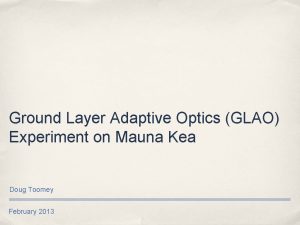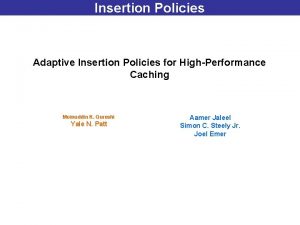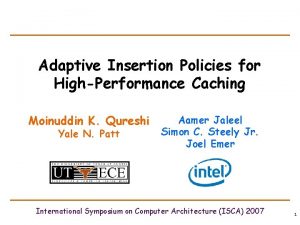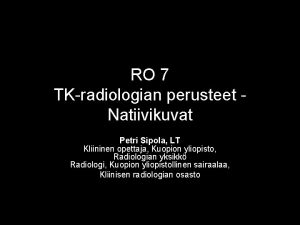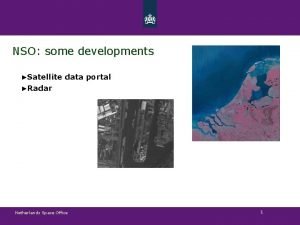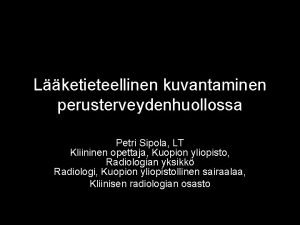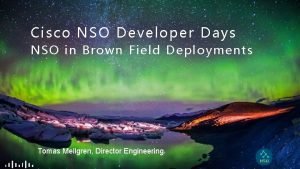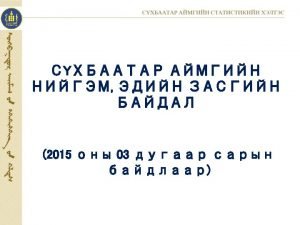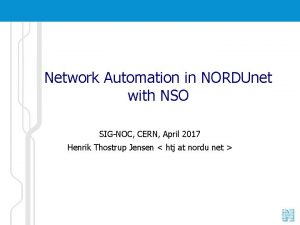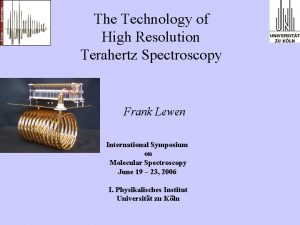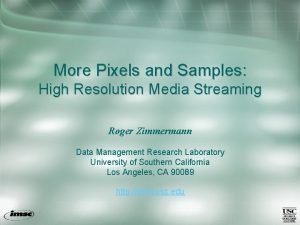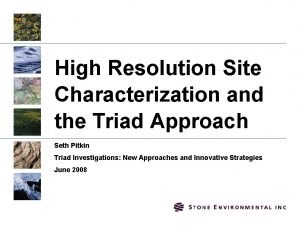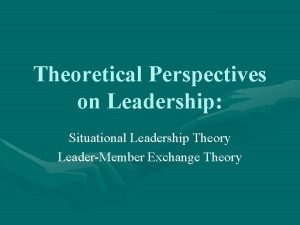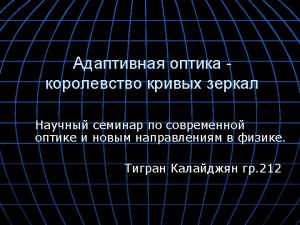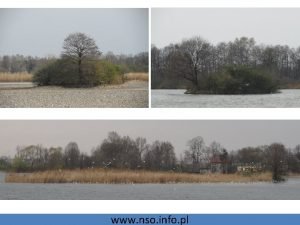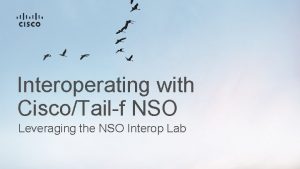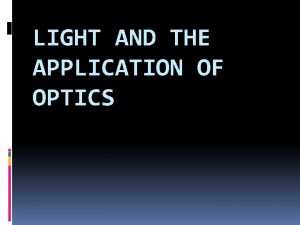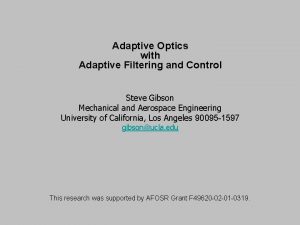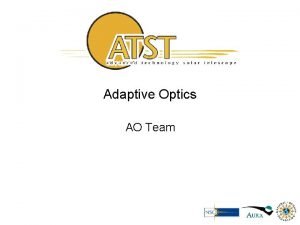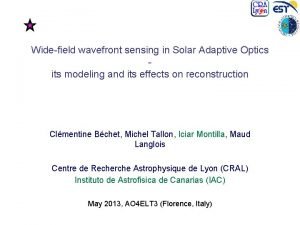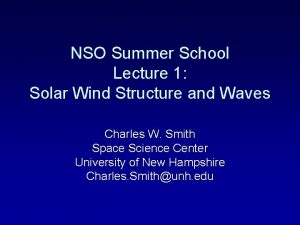High Resolution Science with solar Adaptive Optics NSO




























- Slides: 28

High Resolution Science with solar Adaptive Optics NSO AO Heritage T. Rimmele 1

Ground-based Advantage • larger apertures • and therefore w/adaptive optics higher resolution (at given λ) • Well/best suited for high resolution IR (large r 0) observations – magnetic sensitivity • higher photon flux – sensitivity & cadence • coronal magnetometry require large apertures. • more sophisticated, more powerful & up-to-date instrumentation is available at ground based telescopes. • flexibility and complexity to bring many different diagnostic tools to bear on a problem • high data rates/volumes • pathfinder for space based experiments • COST $$$$$ - if it can be done from the ground it should be done from the ground!! June 10 -12, 2007 2

. 10 -31 -2006 3

Stable, high-Strehl resolution for long-periods of time at high magnetic sensitivity NIR wavelengths F. Woeger, 430 nm e. g: 4 m ATST/1300 dof AO on Haleakala S>0. 6, i. e. , space quality imaging, for 90% of the clear time!! June 10 -12, 2007 4

Wavefront Control is Essential • Quasi-static alignment (QSA): – for keeping the entire optical path- most importantly M 1 and M 2 - aligned in closed-loop. • The active optics (a. O) system: – keep the figure of M 1 within spec compensating for deformation due to gravitational and thermal distortions. • Tip/tilt devices for image stabilization. • High order adaptive optics (HOAO): – for correcting atmospheric and internal seeing and residual optical aberrations. 10 -31 -2006 5

The Prototype: Dunn Solar Telescope AO works great and produces good science • Two 97 actuator systems operational since 2000 • Used routinely for observing runs - > 90% of actual observing time • Operated by observing staff (2 people) – Optical setup and alignment (after optics cleaning or re-coating) – Calibration procedures – Operate AO and Science Instruments • Impressive Science Output – Over-subscribed DST – Many publications based on AO data – Recognition of (old) DST as one of the most productive high res solar telescopes – DST competes well with new Swedish Telescope –Scharmer 2006: “You have a better AO system” 10 -31 -2006 6

DM WFS FIBER IF DLSP 10 -31 -2006 UBF 7

Experimental Bench 10 -31 -2006 8

3 sec exposure Tip/tilt on 10 -31 -2006 9

AO loop on 500 nm 10 -31 -2006 10

Solar Adaptive Optics Performs as Advertised Vw=10 m/s; fs=300 Hz=-3 d. B BW Pupil Misalignment? WFS noise anisoplanatism? Model includes: • Fitting error • Aliasing • Bandwidth • WFS noise 10 -31 -2006 11

LE PSF estimation from AO loop data Dopplergram - well, not really June 10 -12, 2007 This is more like it!! J. Marino 12

A. Tritschler June 10 -12, 2007 13 NSO/HAO/KIS Diffraction-Limited Spectro Polarimeter

Solar MCAO is becoming a reality! MCAO DM 2 @ 6 km, target: granulation 10 -31 -2006 Conventional AO 14

Examples of Science Results with a personal bias, of course! • • Dynamics of g-band bright points (BP) Spectroscopy of g-band BP Flare observations at the diffraction limit Chromospheric dynamics – Wave propagation – Acoustic Shocks • Sunspot dynamics – Penumbra and Evershed effect (keep those theoreticians honest!) – Umbral sub-structure (keep those …. ) 10 -31 -2006 15

DLSP Speckle Imager 2 kw 2 k, 25 fps Frame selection Speckle bursts Virtual camera Prototype 10 -31 -2006 16

AO + Speckle Oct. 2003 Region which produced Halloween events 10 -31 -2006 17

Diffraction limit achieved - We are beginning to detect substructure in umbral dots gband 10 -31 -2006 18

…. and we can perform quantitative physical measurements Only possible with AO (14 sec exposure)! 10 -31 -2006 Integrated Fe. I 5434 line absorption 19

… which will allow us to test models/simulations Umbral Dots 10 -31 -2006 Simulations by Schuessler&Voegler 2006 20

Sample High-Resolution Spectra • Fe. I 1564. 8/1565. 3 nm, g = 3/1. 5 line pair is the most sensitive line pair for magnetic field measurements • NIR-polarimetry is essential tools for weak fields • Currently about 0. ” 4 resolution (diffraction limit) 10 -31 -2006 Lin @ DST 21

Quiet Sun Observations • Most challenging for AO – Lock on low-contrast granulation – Keep lock for hours – Can be done routinely at DST in seeing of <1”. 5 • Comments concerning this data set: – Service Observing • important operational mode for ATST – Several groups are working on these data – open data • US, Italy, India • Requested by M. Carlsson, Norway –”it’s a unique data set at this point” • New insights into Chromospheric Dynamics 10 -31 -2006 22

Velocity power maps High frequency power – only w/AO 2. 4 -- 4. 0 m. Hz 10 -31 -2006 5. 5 -- 8. 0 m. Hz 23

Spectral profiles vs. time (quiet, high vel. power at > 5. 5 m. Hz) 10 -31 -2006 Courtesy of A. Pietarila 24

‘ 3 -min Shock’ maps Cumulative shocks 10 -31 -2006 5. 5 -- 8. 0 m. Hz vel. power 25

Fe. I 7090 - Ca. II 8542 phase diff. Red > waves propagating upwards 2. 4 -- 4. 0 m. Hz 10 -31 -2006 5. 5 -- 8. 0 m. Hz 26

Testing Penumbral Models 10 -31 -2006 27

Summary • High resolution observations are essential for solving many of the mysteries the Sun still holds – Detailed physical understanding results from comparison of observations and models • Wavefront control is essential to achieve diffraction limit – Solar AO is proven technology and is having a huge scientific impact • Coronal Magnetometry is essential tool to understand coronal structure&dynamics: CMEs, coronal heating • Feasibility of Coronal Marnetometry has been demonstrated with Solar-C&COMP – Need the 4 m aperture for sufficient S/N 10 -31 -2006 28
 Difference between ray optics and wave optics
Difference between ray optics and wave optics Venn diagram of geometric optics and physical optics
Venn diagram of geometric optics and physical optics Adaptive optics
Adaptive optics High resolution low resolution
High resolution low resolution Adaptive insertion policies for high performance caching
Adaptive insertion policies for high performance caching Adaptive insertion policies for high performance caching
Adaptive insertion policies for high performance caching Wholesale solar power panels
Wholesale solar power panels An inexhaustible source of energy
An inexhaustible source of energy My favorite subject is science
My favorite subject is science Nso malpractice insurance
Nso malpractice insurance Natiivikuvaus
Natiivikuvaus Satellite data portal
Satellite data portal Tensiopneumothorax
Tensiopneumothorax Nso developer
Nso developer Nso network
Nso network Cisco nso ned
Cisco nso ned Sources nso frenchhowell neill mit technology...
Sources nso frenchhowell neill mit technology... Tripletta di identificazione nso
Tripletta di identificazione nso Nso.mn
Nso.mn Upenn nso gala
Upenn nso gala Csudh nso
Csudh nso Deiodinacion
Deiodinacion Nso ned
Nso ned Signoc
Signoc High-resolution terahertz
High-resolution terahertz High resolution media
High resolution media High resolution smith chart
High resolution smith chart High resolution site characterization
High resolution site characterization Situational leadership theory emphasizes
Situational leadership theory emphasizes


